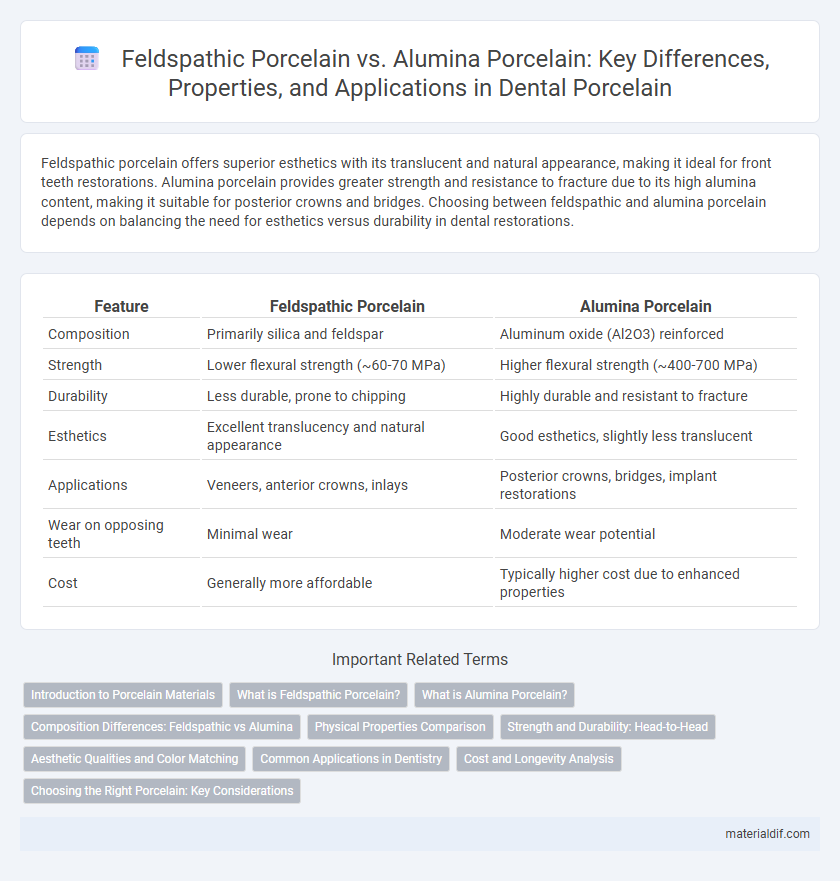Feldspathic porcelain offers superior esthetics with its translucent and natural appearance, making it ideal for front teeth restorations. Alumina porcelain provides greater strength and resistance to fracture due to its high alumina content, making it suitable for posterior crowns and bridges. Choosing between feldspathic and alumina porcelain depends on balancing the need for esthetics versus durability in dental restorations.
Table of Comparison
| Feature | Feldspathic Porcelain | Alumina Porcelain |
|---|---|---|
| Composition | Primarily silica and feldspar | Aluminum oxide (Al2O3) reinforced |
| Strength | Lower flexural strength (~60-70 MPa) | Higher flexural strength (~400-700 MPa) |
| Durability | Less durable, prone to chipping | Highly durable and resistant to fracture |
| Esthetics | Excellent translucency and natural appearance | Good esthetics, slightly less translucent |
| Applications | Veneers, anterior crowns, inlays | Posterior crowns, bridges, implant restorations |
| Wear on opposing teeth | Minimal wear | Moderate wear potential |
| Cost | Generally more affordable | Typically higher cost due to enhanced properties |
Introduction to Porcelain Materials
Feldspathic porcelain, composed primarily of silica, alumina, and potassium oxide, offers superior esthetics and translucency, making it ideal for dental veneers and crowns where natural appearance is critical. Alumina porcelain incorporates aluminum oxide particles, enhancing strength and fracture resistance, suitable for frameworks in restorative dentistry requiring durability. Understanding the material composition and properties allows for optimized selection based on clinical requirements and desired outcomes.
What is Feldspathic Porcelain?
Feldspathic porcelain is a type of dental ceramic primarily composed of feldspar minerals, known for its excellent translucency and esthetic qualities, making it ideal for natural-looking dental restorations. It is a silica-based material that fuses at high temperatures to create a glassy matrix, which provides superior polish and shading capabilities compared to other porcelains. Feldspathic porcelain is commonly used for veneers, crowns, and inlays due to its ability to closely mimic the appearance of natural tooth enamel.
What is Alumina Porcelain?
Alumina porcelain is a type of dental ceramic enhanced with aluminum oxide (alumina) to improve its strength and fracture resistance compared to feldspathic porcelain. It is commonly used in dental restorations requiring high durability, such as crowns and bridges, due to its superior mechanical properties and biocompatibility. The addition of alumina increases the material's toughness while maintaining aesthetic translucency similar to natural teeth.
Composition Differences: Feldspathic vs Alumina
Feldspathic porcelain primarily consists of feldspar, silica, and kaolin, providing excellent translucency and aesthetic properties ideal for dental veneers and crowns. Alumina porcelain incorporates a higher concentration of aluminum oxide (alumina), enhancing its strength and fracture resistance, making it suitable for stress-bearing restorations. The compositional variation between feldspathic and alumina porcelain directly influences their mechanical properties and clinical applications in restorative dentistry.
Physical Properties Comparison
Feldspathic porcelain, composed primarily of feldspar minerals, offers high translucency and esthetic appeal but has lower flexural strength, typically around 60-70 MPa, making it more prone to chipping. Alumina porcelain incorporates alumina particles, increasing its flexural strength significantly to approximately 350-450 MPa, enhancing fracture resistance and durability while slightly reducing translucency. The higher alumina content also improves wear resistance and thermal stability, making alumina porcelain preferable for load-bearing dental restorations.
Strength and Durability: Head-to-Head
Feldspathic porcelain offers excellent esthetics with a natural translucency but has lower strength and durability, making it more prone to chipping and fractures under heavy occlusal forces. Alumina porcelain, reinforced with aluminum oxide crystals, provides significantly higher flexural strength and fracture resistance, which translates to superior longevity in crown and bridge restorations. Clinical studies demonstrate that alumina-based porcelains withstand masticatory stresses better than feldspathic options, making them ideal for posterior restorations subjected to intense functional loads.
Aesthetic Qualities and Color Matching
Feldspathic porcelain offers superior aesthetic qualities due to its translucent nature, closely mimicking the natural enamel of teeth for highly realistic restorations. Alumina porcelain, while stronger and more durable, has a more opaque appearance, which can limit its ability to achieve perfect color matching in cosmetic dental work. Dentists often prefer feldspathic porcelain when prioritizing lifelike appearance and precise shade matching for anterior teeth restorations.
Common Applications in Dentistry
Feldspathic porcelain is commonly used in veneer and anterior crown restorations due to its superior esthetic qualities and excellent translucency that closely mimics natural tooth enamel. Alumina porcelain is preferred for posterior crowns and fixed partial dentures because of its enhanced strength and fracture resistance, making it suitable for areas subjected to higher occlusal forces. Both materials are integral in restorative dentistry, with feldspathic porcelain emphasizing esthetics and alumina porcelain prioritizing durability.
Cost and Longevity Analysis
Feldspathic porcelain is generally more affordable due to its simpler composition but offers lower durability, making it ideal for less load-bearing dental restorations. Alumina porcelain, enriched with aluminum oxide, provides superior strength and longevity, often lasting significantly longer in high-stress areas but comes at a higher cost. Cost-effectiveness depends on balancing initial investment against the potential need for replacements, with alumina porcelain favored for long-term performance.
Choosing the Right Porcelain: Key Considerations
Feldspathic porcelain offers superior aesthetics due to its translucency and natural appearance, making it ideal for anterior restorations, while alumina porcelain provides enhanced strength and durability suitable for posterior crowns and bridges. When choosing the right porcelain, factors such as the restoration's location, esthetic demands, and mechanical stress should be carefully evaluated to ensure optimal performance. Clinicians must balance these considerations to select a material that meets both functional requirements and patient expectations.
Feldspathic Porcelain vs Alumina Porcelain Infographic

 materialdif.com
materialdif.com